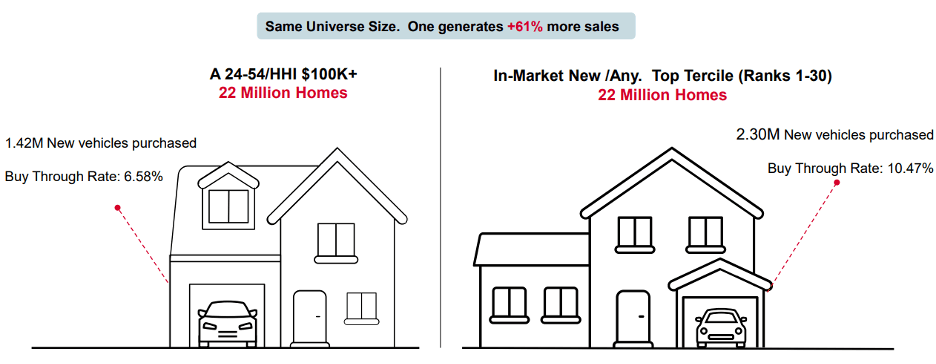Campaign measurement: Let’s talk about our observational bias

There’s a well-known allegory that relates perfectly to how many marketers approach branding campaigns: with observational bias. As the tale goes, a police officer sees a person searching for something under a streetlight and asks what was lost. The person responds, “looking for my keys” and the police officer asks, “Are you sure you lost them here?” And the person replies, “No, but this is where the light is!”
Let’s face it — we’re all more likely to search for something where it’s easiest to look. But just because it’s easier to look where the light is, does not mean whatever is lost will be found there. This is the Streetlight Effect, and it has been playing out for years in the TV/branding versus digital/performance approach to calculating ROI.
Branding campaigns consider demographic targets the way I consider defensive tackles for my beloved Kansas City Chiefs; large, not overly refined, and able to get in front of opposing players – or in this case, large swatch of potential customers. It’s a big numbers game with success largely determined by how many people saw the ad (reach) and how many times (frequency).
Conversely, performance campaigns take a laser focused approach, targeting prospects at the most granular level – like left-handed ventriloquists who are heavy buyers of mouthwash. These campaigns optimize towards the things known about an audience and around easily measured indicators like clicks, traffic, downloads, sign-ups, and other trackable actions.
Neither approach is perfect. Demo targets put broad reach campaigns in front of millions of people – with poor conversion. Meanwhile, highly targeted performance campaigns are so focused on efficiency and the race to be the last impression counted, that they miss out on the light-to-medium users that grow sales.
Branding and performance efforts work better together. Yet their performance and accountability historically skew to measure ad metrics rather than actual business results, so many use the “vanity metrics” because that is where the light is shining and it’s the easiest option.
But, we have more light. Media budgets have already shifted to more addressable and measurable channels like digital. This means combining the best of brand marketing with the best of performance marketing is possible — and allows companies to see how their campaigns are actually driving business results.
Just look at what’s happening in TV – more dollars and eyeballs are shifting away from traditionally bought linear toward more addressable forms of television advertising.
The marketers who limit their measurement strategies to the old paradigm will be left behind in this new world.
Targeting
Let’s talk about branding campaigns and what’s possible in terms of targeting and measurement today, using automotive as an example.
Today, U.S. car buyers have nearly 450 models to consider. Within five years, that number will grow by 30 percent, mostly driven by the surge of electric vehicles coming to market. Soon, approximately 650 models will be competing for showroom space, lot space, digital space, marketing budget, and most importantly, consumer attention.
The added complexity this will entail for marketing will be transformative.
Let’s do some fast math:
There are roughly 131 million households in the US.
- 117 million can drive a car 68 million households can buy a car
- 52 million households can buy new cars
That equates to only 52% of U.S. households potentially buying a car, and only 40% of households possibly considering new.

Let’s compare that to a few commonly used demographic groups:
- Adults 18-49: 47 million
- Adults 18-49 AND HHI $100k+: 19 million
- Adults 25-54: 56 million
- Adults 25-54 AND HHI $100k+: 24 million
Looking at that last group — adults between 25-54 with a household income of $100,000 or more — stands as one of the most popular demographic segments targeted with new car advertising. These adults bought 1.42 million new vehicles over the last 12 months, for a purchase rate of 6.58%.

Targeting the same number of households (22 million) but with an in-market audience approach instead of demographics, the purchase rate jumps to 10.47% and the number of vehicles sold jumps to 2.3 million – a 61 percent increase in sales. No sacrifice in scale, but more than a 60 percent improvement in performance.
So, what can you do now to see better results?
- Buy more addressable media. The higher perceived cost can be more than justified by higher ROI and ROAS.
- Use data from trusted sources that provide both scale and quality.
- Measure actual business results.
The “streetlight” of addressable media, where you can put your message in front of a relevant audience and measure actual business results, has never been brighter.
This op-ed represents the views and opinions of the author and not of The Current, a division of The Trade Desk, or The Trade Desk. The appearance of the op-ed on The Current does not constitute an endorsement by The Current or The Trade Desk.
Subscribe to The Current
Subscribe to The Current newsletter